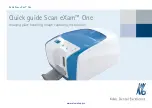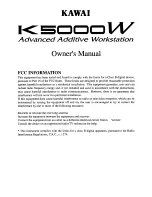
Oxygen Concentrator
11
Theory of Operation
Introduction
The Companion 5 is a stationary medical device used to extract
oxygen from the atmosphere, concentrate it, and present the oxygen
to the patient. The device will operate in Continuous Flow Mode. In
Continuous Flow Mode the oxygen is provided at a con-stant flow rate
between 0.5 and 5.0 LPM (Continuously Variable).
Table 2 below lists the major internal components of the concentrator
and their functions. Reference Table 2 and Figure 3 (on the following
page) for clarification while reading the Theory of Operation Section
of the manual.
Item
Function
HEPA Air
Intake Filter
Provides HEPA level filtration for
intake to compressor.
Compressor
Pump that routes air into and through
the concen-trator.
Cooling Fan
Cools the compressor area.
Solenoid
Valve
Routes air flow through one sieve bed and
vents the purged air to the atmosphere from the
other bed. Responsible for alternating flow
between the beds.
Sieve Beds
Chemically adsorbs nitrogen
molecules from the air.
Orifice
Routes a larger portion of air exiting one sieve
bed back through the other bed for purging.
Flapper Valve
Routes a smaller portion of air exiting one sieve
bed into the product holding tank. Prevents back
flow from product tank to sieve bed
Product
Holding Tank
Holds concentrated oxygen prior to its
regulation and delivery to the patient.
Pressure
Regulator
Reduces the outlet pressure to be compatible
with the flow meter and accessories.
OCSI Sensor
Detects oxygen concentration of flow exiting the
concentrator. Sends a signal to activate alarm if
concentration is too low.
Flow Control
Valve
Integral needle valve that controls
volumetric flow (LPM) to the patient. Is read
against the printed scale.
HEPA Disc Filter
HEPA level filtration of outlet flow.
Printed Circuit
Board (PCB)
Responsible for all of the electrical operation of
the concentrator. Contains a programmable
microprocessor that controls valve timing, alarm
indications, and OCSI functions (if applicable).
Optional Gross
Particle Filter
(Top Handle)
Provides gross particle filtration for intake
to compressor.
Required Gross
Particle Filter
(Bottom)
Provides gross particle filtration for
intake to compressor.
Table 2: Internal Components of Concentrator
Pressure Swing Adsorption
The CAIRE Companion 5 utilizes the Pressure Swing Adsorption
(PSA) Process to concentrate oxygen gas from ambient air. In the PSA
process, a compressor draws ambient air into the machine through an
intake filter. The compressor then forces the filtered air into a solenoid
valve which directs the air into one of two tanks that are full of a
molecular sieve material, referred to as sieve beds. As the pressure in
sieve bed 1 increases, nitrogen molecules are removed from the
ambient air and are stored in the sieve material. The gas that exits
sieve bed 1 is highly-concentrated oxygen. The majority of this gas
flows through an orifice to sieve bed 2 and is used to purge the stored
nitrogen gas from its sieve material. The remainder of the oxygen gas
is directed through a flapper valve to the product holding tank. Here, it
is stored for delivery to the patient.
Sieve bed 1 continues to pressurize until the sieve material is
completely saturated with nitrogen. At this time the printed circuit
board (PCB) switches the state of the solenoid valve, dumping
pressurized air in sieve bed 1 back into the atmosphere via the purge
muffler. Simultaneously, the valve now directs the compressed air into
sieve bed 2, which has been completely purged of nitrogen gas and is
ready for nitrogen adsorption/oxygen concentration. This cycle
continuously repeats pressurizing and depressurizing the sieve beds,
feeding concentrated oxygen to the product holding tank.












































